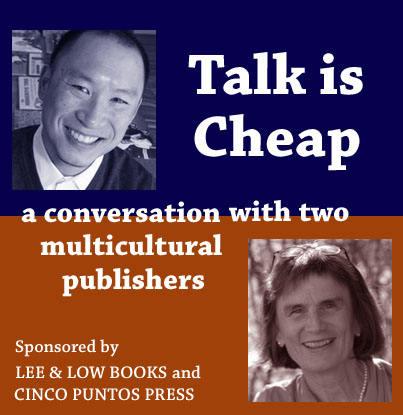Summer is in full swing and that means lots of exciting trips to be planned! We’ve pinned a list of picture books about travel on our new Pinterest board, so you can travel the world without spending money or suffering from jetlag!
Tag Archives: diversity
Why Hasn’t the Number of Multicultural Books Increased In Eighteen Years?
Note: This post was originally posted in June 2013. An updated study with new statistics can be found here. The infographic below has also been updated.
Since LEE & LOW BOOKS was founded in 1991 we have monitored the number of multicultural children’s books published each year through the Cooperative Children’s Book Center’s statistics. Our hope has always been that with all of our efforts and dedication to publishing multicultural books for more than twenty years, we must have made a difference. Surprisingly, the needle has not moved. Despite census data that shows 37% of the US population consists of people of color, children’s book publishing has not kept pace. We asked academics, authors, librarians, educators, and reviewers if they could put their fingers on the reason why the number of diverse books has not increased. Continue reading
ALA Book Buzz: A Conversation with Two Multicultural Publishers
If you’ll be at ALA in Chicago this year, please join Lee & Low Books and Cinco Puntos Press for a special ALA Book Buzz session on Monday morning:
Where’s the Diversity? The Tony Awards Looks in the Mirror
Though we are a publisher of children’s books, part of our mission is to look at diversity issues with a critical eye and see whose stories are not being told. As part of that mission, over the next several months we will be looking at several different arenas and talking to experts to see if patterns of inequality repeat themselves in different places. We hope our research will cast a light on the challenges – and opportunities – facing women and people of color today.
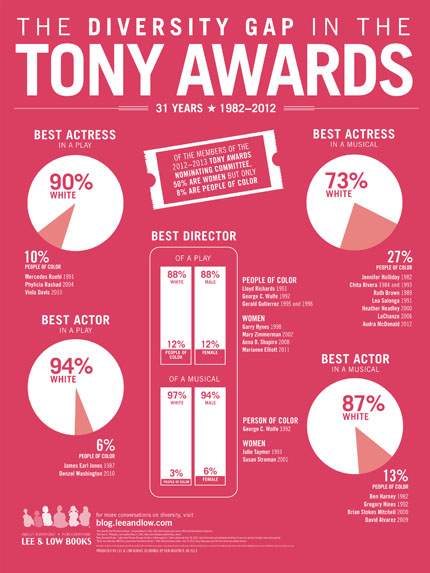
Since the Tony Awards will be presented on June 9, 2013, we decided to collect some data to see if a diversity gap exists in the theater. See our infographic above. While we cannot claim expertise in other fields outside of children’s books, we were fortunate to receive valuable insight from playwright/actor Christine Toy Johnson, who has spent the last fifteen years conducting dialogue with the entertainment industry to increase diversity in the theater and beyond.
 CHRISTINE TOY JOHNSON is an award-winning writer, actor, filmmaker, and advocate for inclusion. Member: BMI Workshop, Dramatists Guild, ASCAP, AEA, SAG-AFTRA, Asian
CHRISTINE TOY JOHNSON is an award-winning writer, actor, filmmaker, and advocate for inclusion. Member: BMI Workshop, Dramatists Guild, ASCAP, AEA, SAG-AFTRA, Asian ![]() American Composers and Lyricists Project (founder), executive board of Alliance for Inclusion in the Arts, elected leadership of Actors’ Equity Association (and co-chair of the union’s EEOC), founding steering committee member of AAPAC. {Read more}
American Composers and Lyricists Project (founder), executive board of Alliance for Inclusion in the Arts, elected leadership of Actors’ Equity Association (and co-chair of the union’s EEOC), founding steering committee member of AAPAC. {Read more}
How old were you when you knew you wanted to perform onstage?
I can’t remember an age when I didn’t want to perform onstage. I was the kind of kid who made my parents’ holiday guests watch my dramatization of “The Twelve Days of Christmas” every year. I started working professionally (and joined Actors’ Equity Association) the summer I graduated from high school, and against all odds, I have made my living in the arts ever since, as both an actor and a writer.
Since you have been involved in the theater for so long, how have you seen the theater world change? Do you feel that the number of roles available to people of color has increased over the years?
Things have gotten better for people of color, for sure, but there is obviously a lot of room for improvement.
I want to preface all of this by saying that I can only really speak from the perspective of being an Asian American actor and writer. I can’t presume to know what it’s like to be African American, Latina, Native American, etc., but the stats I’ve included from AAPAC (see below) will be able to address this question from a more objective point of view.
Back in 1991, I got a chance to play Julie Jordan in a production of CAROUSEL at the Hangar Theatre in Ithaca, 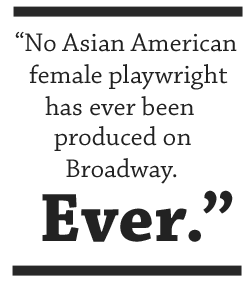 New York, which was a watershed moment for me. Not only was I shocked that I was being given the opportunity to audition (back then, a rare occurrence), but after I booked the job, working with a director and company of actors that supported me and believed in my ability to transform into a non-Asian character in a classic golden age musical gave me the confidence to go for and go on to play many, many more classic non-Asian leading lady roles. The power of encouragement and affirmation from your peers cannot be underestimated.
New York, which was a watershed moment for me. Not only was I shocked that I was being given the opportunity to audition (back then, a rare occurrence), but after I booked the job, working with a director and company of actors that supported me and believed in my ability to transform into a non-Asian character in a classic golden age musical gave me the confidence to go for and go on to play many, many more classic non-Asian leading lady roles. The power of encouragement and affirmation from your peers cannot be underestimated.
As a playwright/librettist/lyricist, I am also acutely aware of the number of writers of color that are being produced, which is a key part of this puzzle. (More on that in a later question.) Personally, I am conscious of always either including an Asian American actor in my written work or telling an aspect of an Asian American character’s story. I believe that the only way we’ll see our roles increase is if more of our stories are produced (written by and/or about us), and/or if more playwrights/directors/producers are open to having people of color play non-race specific roles they write/direct/produce.
10 Great Resources for Teaching About Racism
It’s been 59 years since Brown vs. Board of Education overturned the “separate but equal” doctrine in schools, but that doesn’t mean discrimination has disappeared from the classroom. Teaching children about race can be a tricky topic, but luckily, there are many great resources and books out there. Our new picture book, As Fast As Words Could Fly, takes a unique look at school desegregation, following an African American family in North Carolina in the midst of the Civil Rights Movement. Based on the experiences of author Pamela Tuck’s father, it’s proof that just one young person could – and still can – make a big difference.

The Gift of Hope: Guadalupe Garcia McCall on first books

![]() Our recent grant from First Book inspired us to ask our authors about the crucial role multicultural books play in children’s lives. Guest blogger, author/poet Guadalupe Garcia McCall, reveals how the mission of First Book, to get low-income children their very first book, is a reality that many children face, including herself when she was growing up.
Our recent grant from First Book inspired us to ask our authors about the crucial role multicultural books play in children’s lives. Guest blogger, author/poet Guadalupe Garcia McCall, reveals how the mission of First Book, to get low-income children their very first book, is a reality that many children face, including herself when she was growing up.
First Book’s mission to make books accessible to low-income families is very close to my heart. It fills me with joy to hear that such an organization exists. Books are more than important, they fill a basic need in low-income communities—the need to connect to the world. Books for children of poverty represent hope.
As a young girl, I loved books. Books were my friends. They took me places I knew I would never be able to visit because we were poor. After my mother passed away, my father couldn’t leave town to work anymore, so he had to settle for working in Eagle Pass. He did odd jobs, put in a toilet for a friend and got a few bucks. Sometimes he got lucky and someone needed him to take out the flooring on their mobile home and put in a new one; then he had enough money to pay the bills for the month and buy a few groceries. We didn’t have money for anything other than food and bills.
Book-Hungry Hands: A guest post by Pat Mora
 Our recent grant from First Book prompted us to ask our authors to reflect on why diverse books are important. Guest blogger,
Our recent grant from First Book prompted us to ask our authors to reflect on why diverse books are important. Guest blogger, ![]() author/poet Pat Mora, talks about witnessing the special connection Spanish-speaking children make with books that include their culture and language.
author/poet Pat Mora, talks about witnessing the special connection Spanish-speaking children make with books that include their culture and language.
“Once upon a time . . .” A magic phrase that can change our breathing. As far as we know, humans are the world’s story-telling creatures. Let’s think about the unique period in the lives of children when they begin to savor that phrase, when in fresh ways little ones are experiencing their surroundings and deciding where they fit.
For many youngsters, media is their main source of information and entertainment. Children lucky enough to become readers discover that they can read those once-upon-a-time words to themselves—and others. They discover the pleasure and power of words. Since words and books are powerful, how can we doubt that the images of children, families, and cultures in their books have a subtle and significant impact on young readers and their families? Who merits having their stories shared and who doesn’t? How does it feel not to see people like you between the covers of beautiful books? Are all our books created and valued equally?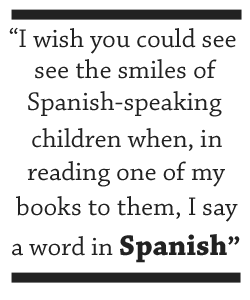
Growing Up without Books: Discovering DeShawn
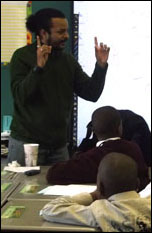 In light of our grant from First Book we asked our authors to reflect on why diverse books are
In light of our grant from First Book we asked our authors to reflect on why diverse books are ![]() important. Guest blogger, author/poet Tony Medina talks about growing up in the projects without books and later as an author witnessing the true power of connecting multicultural books with children of color.
important. Guest blogger, author/poet Tony Medina talks about growing up in the projects without books and later as an author witnessing the true power of connecting multicultural books with children of color.
As a child in the Throgs Neck Housing Projects in the Bronx, I did not grow up with books. The only person I saw reading was my grandmother, who occasionally read mass-market paperback fiction and her Bible that was as big as a phone book. If the Bible fell from the top of the dresser where she kept it, it could take your kneecap off and crush your foot in the process! The only time I recall being exposed to children’s books was at school when the teacher took us to the school library and the librarian allowed us to take out Curious George books.
Reading Biographies to Reflect on Core Principles and Create Belonging
 Guest blogger Katie Cunningham is an Assistant Professor at Manhattanville College. Her teaching and scholarship centers around children’s literature, critical literacy,
Guest blogger Katie Cunningham is an Assistant Professor at Manhattanville College. Her teaching and scholarship centers around children’s literature, critical literacy, ![]() andsupporting teachers to make their classrooms joyful and purposeful. Katie has presented at numerous national conferences and is the editor of The Language and Literacy Spectrum, New York Reading Association’s literacy journal.
andsupporting teachers to make their classrooms joyful and purposeful. Katie has presented at numerous national conferences and is the editor of The Language and Literacy Spectrum, New York Reading Association’s literacy journal.
Spring is here and with that spring fever for many students who will be graduating from a significant milestone and moving on to the next stage of their lives. Graduating students will hear speeches that urge them to seize the day, to work hard, to stand out amongst the crowd, and to answer the question “Who will you be?”. The Common Core State Standards are written with this day in mind. While the standards are designed to raise the level of education that any child receives regardless of socioeconomic status, race, gender, and language, the standards alone do not put children on the path to college and a career. We cannot overlook that some students see themselves from a very early age as “card carrying members” in college settings while others feel displaced. Before we can ask our students “Who will you be?”, we need to wonder “Who do our students believe they can be?”
 The last few springs I’ve hosted seventy-five fifth graders to the college campus where I’m an Assistant Professor. These fifth graders attend a school where 93% are of Latino descent, 85% have reduced or free lunch, and almost 40% have limited English proficiency. For many of them this experience is their first time on a college campus and the vast majority will be the first generation in their families to attend college. The trip is only five miles by school bus, yet our campus is a world away for many students. The trip is designed to give fifth graders the sense that they are card-carrying members. That they belong here. That they are on the road to college as a pathway to a career.
The last few springs I’ve hosted seventy-five fifth graders to the college campus where I’m an Assistant Professor. These fifth graders attend a school where 93% are of Latino descent, 85% have reduced or free lunch, and almost 40% have limited English proficiency. For many of them this experience is their first time on a college campus and the vast majority will be the first generation in their families to attend college. The trip is only five miles by school bus, yet our campus is a world away for many students. The trip is designed to give fifth graders the sense that they are card-carrying members. That they belong here. That they are on the road to college as a pathway to a career.
As educators and parents, we know that college and career-readiness cannot simply be reduced to a series of skills-based standards. Rather, it’s a complex topic with social, cultural and political considerations that go far beyond the classroom. I believe we can enact curriculum that centers the standards in engaging and joyful ways, but what can we do to rewrite history for many of our students who face obstacles inside and outside our classrooms everyday? We can bring them to college campuses and support them to see themselves as members of intellectual communities. We can also support students beyond single events to routinely consider what guides us and what has guided people before us to reach their dreams. Harvard Professor Ronald Ferguson established five core principles I believe our schools must teach long before and alongside any reading, writing, or math lessons:
The Only Book in the House
![]()
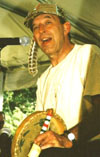 In light of our recent grant from First Book we decided to ask our authors to reflect on the idea of receiving one’s very first book. Guest blogger, author Joseph Bruchac talks about the influence books have had on his life and the continued importance of books in the lives of children today.
In light of our recent grant from First Book we decided to ask our authors to reflect on the idea of receiving one’s very first book. Guest blogger, author Joseph Bruchac talks about the influence books have had on his life and the continued importance of books in the lives of children today.
What does a book mean to a child? A book all his or her own? I can’t remember a time when I didn’t have books. I was raised by my grandparents in a house full of books that belonged to my grandmother. I loved to pull the books off the shelves and look through them, even when I didn’t understand most of the words.
But what meant the most to me was having my own books. It wasn’t easy to get books when I was a child. This was long before Borders, Barnes & Noble, and ordering books online. We lived in a small rural town, far from the nearest bookstore. One of the most exciting things for me was when my grandmother drove me to Glens Falls, twenty miles away, where there was a bookstore with a small children’s section. For the two dollars saved from my monthly allowance, I could buy a book—usually about nature—such as one of those in the Old Mother West Wind series by Thornton W. Burgess. All the way home I’d sit in the back of our old blue Plymouth, clutching that new book, eager to open its pages and be lost in the world it created for me.


